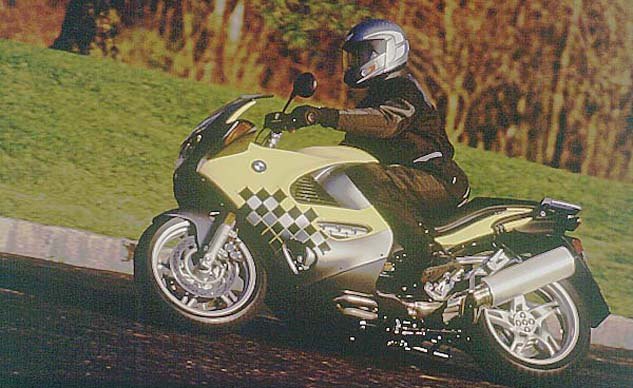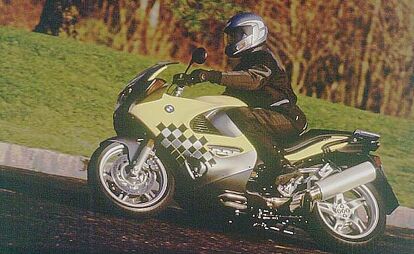Church Of MO – First Impression: 1998 BMW K1200RS

It’s big, it’s heavy, and it’s undeniably BMW. In this week’s Church of MO, we’re going back to 1998 to see how Billy Bartels got along with BMW’s autobahn burner, the K1200RS. Today the K bikes are known as sport-touring machines known more for their touring abilities, but capable of handling a twisty road or two if needed. Before the K12 however, the K bikes had a reputation for being big porkers with incredible reliability being its main redeeming quality. Truth be told, K bikes are still rather portly, but BMW has found a way to turn that into a positive. Read on and you’ll see that Bartels agrees.
First Impression: 1998 BMW K1200RS
Autobahn Baby
By Billy Bartels Feb. 20, 1998
Photos by BMW and Bartels
“What do you choose to ride,”we pondered in our original Open Sportbike Shootout “if you need to be in Denver tomorrow? If you need a bike that will travel highway miles, but still leave a smile on your face in the twisties, and leave everyone else in the weeds?” BMW thinks they have a solution for that dilemma. The new K1200RS.
Although supported by a fanatical core of enthusiasts, BMW’s famed K-bike was flawed. It was obvious that in order to grab a bigger share of an increasingly competitive market, the quirky — yet reliable — K was going to need a major redesign. Key complaints against the “flying brick” were threefold: 1) It Buzzed 2) It was slow 3) The handling wasn’t so great. Why the fanaticism? Simple, they were great long-distance tourers that tended to be more exciting than riding a Winnebago (Goldwings, FLTs, etc…). They also tended to last 200,000-plus miles.
BMW’s new K1200RS was designed with the goal of fixing the K-bike’s shortcomings while still respecting the model’s legendary sport-touring status. BMW informed us that above all they would not compromise the touring ability of the RS for sporting prowess.
BMW succeeded, with such touches as adjustable clip-ons, footpegs and shifter, and an improved two-position seat. Carried over from elder Beemers was BMW’s patented Paralever Shaft drive, as BMW refuses to blend into the sportbike crowd with a chain drive. Contributing to the even feel is BMW’s first six-speed transmission. Smoother than its five speed predecessor, it’s also equipped with a higher top gear ratio.
That fabled K-bike buzz is gone. A rubber isolated engine/tranny combo still buzzes, perhaps more than the old one, but none of it ever reaches the rider. Only in a small section of rpm between 4200 and 4700 does the chassis harmonize with the motor. As you might expect, isolating the engine required a significant weight penalty in the form of a complex and heavy (53 pound) aluminum frame.
While BMW’s chassis technicians were tuning out the buzz, their engine-eers were adding shovel-loads of horsepower. The result? ‘Slow’ is not in this bike’s vocabulary. BMW claims an awesome 130 rear wheel horsepower for the RS.
Impressive as that figure is, its torque figures are even more outstanding. There is a hearty 65 ft-lbs of torque at 3000 rpm and 85 ft-lbs at 6750, and that means unparalleled passing power and acceleration. During impromptu top-gear runs, we were able to bump 145 mph and it was still pulling hard. Clearly, there was plenty more to be had.
With an engine capable of effortless triple-digit cruising, BMW knew their ‘bahn-burner would need effective bodywork. The windtunnel-designed unit fitted to the 1200 offers excellent wind protection, even at higher speeds. In fact, it may even be overkill for travel in the U.S., as speeds under 70 mph tend to place a bit too much weight on your wrists.
While on the topic of speed, this thing is Stable (capital intended). Trying to induce headshake is futile, as the RS refuses to shimmy. BMW claims this innate stability is partially due to a two-stage steering damper (more on that later), and also to the Metzeler tires and their “zero ratio” construction.
An unusual design choice was a 5mm right offset of the rear wheel. According to BMW engineer Berthold Hauser, this makes up for a slight weight bias to the right. Conventional engineering would expect the bike to shimmy in corners, but we can attest this is not the case.
The trade off for such stability is that the K12 is not a quick steerer. Flickability is significantly slowed by the steering damper and the lengthy (61 inch) wheelbase. The two-stage damper is not noticed when diving into a turn, but you’ll feel it during a full-lean transition. BMW never intended this bike to be a canyon strafer. Instead it excels on those long sweeping corners that are so abundant in South Carolina.
Pulling the claimed 630-pound (wet) beast down from speed you’ll find tried and true four-piston Brembos, equipped with BMW’s Anti-Lock II. It’s been said before – this system works. Don’t worry, just grab a handful of brakes and the bike will do the rest. You feel odd doing it, but it’s easy to get used to. Anti-dive rates have been increased, reflecting the K12’s sportier focus and further contributing to the bike’s confidence-inspiring ride.
Time for a reality check. The new K1200RS is first and foremost a touring bike. It’s just that this touring bike goes really, really fast.
What could be a major drawback in the touring department is the fact this thing sucks gas. Ridden aggressively, it will only return about 30 mpg, although one BMW staffer was happy to loaf along in sixth, netting over 40 mpg. Range as tested came in around 200 miles.
At $15,999, BMW’s K1200RS is high compared to its Japanese competition. BMW officials were quick to point out though, that the K1200RS is less than four percent higher than their old K1100RS. When you crunch the numbers that way, their new and improved RS is quite reasonably priced.
700 miles later we wish we had more challenging twisties to test the bike in. What we discovered in the long, sweeping curves of South Carolina was a good touring bike with a real serious engine – not some watered-down liter bike. BMW’s new K1200RS is a genuine performance-tuned, big-bore tourer that’ll have you looking forward to that next bend in the road.
Specifications:
Manufacturer: BMWModel: 1998 K1200RSPrice: ,990Engine: Liquid/oil cooled inline four-cylinderBore x stroke: 70.5mm x 75mmDisplacement: 1171ccCarburetion: Bosch Motronic fuel injection Transmission: Six speedWheelbase: 61 inches (unladen)Seat height: 30.3/31.5 inchesFuel capacity: 5.5 gallonsClaimed dry weight: 586 lbs.Claimed wet weight: 628 lbs.

Troy's been riding motorcycles and writing about them since 2006, getting his start at Rider Magazine. From there, he moved to Sport Rider Magazine before finally landing at Motorcycle.com in 2011. A lifelong gearhead who didn't fully immerse himself in motorcycles until his teenage years, Troy's interests have always been in technology, performance, and going fast. Naturally, racing was the perfect avenue to combine all three. Troy has been racing nearly as long as he's been riding and has competed at the AMA national level. He's also won multiple club races throughout the country, culminating in a Utah Sport Bike Association championship in 2011. He has been invited as a guest instructor for the Yamaha Champions Riding School, and when he's not out riding, he's either wrenching on bikes or watching MotoGP.
More by Troy Siahaan


















































Comments
Join the conversation
Still a great touring bike (with a hint of sport) that can be had at a bargain price. And you'll never wear it out (except for the rear drive bearing). If only it had a bigger tank.
628lbs ready to ride . . . HOLY SH%# ! 😳
Where they even actually trying to make it at least average weight ?